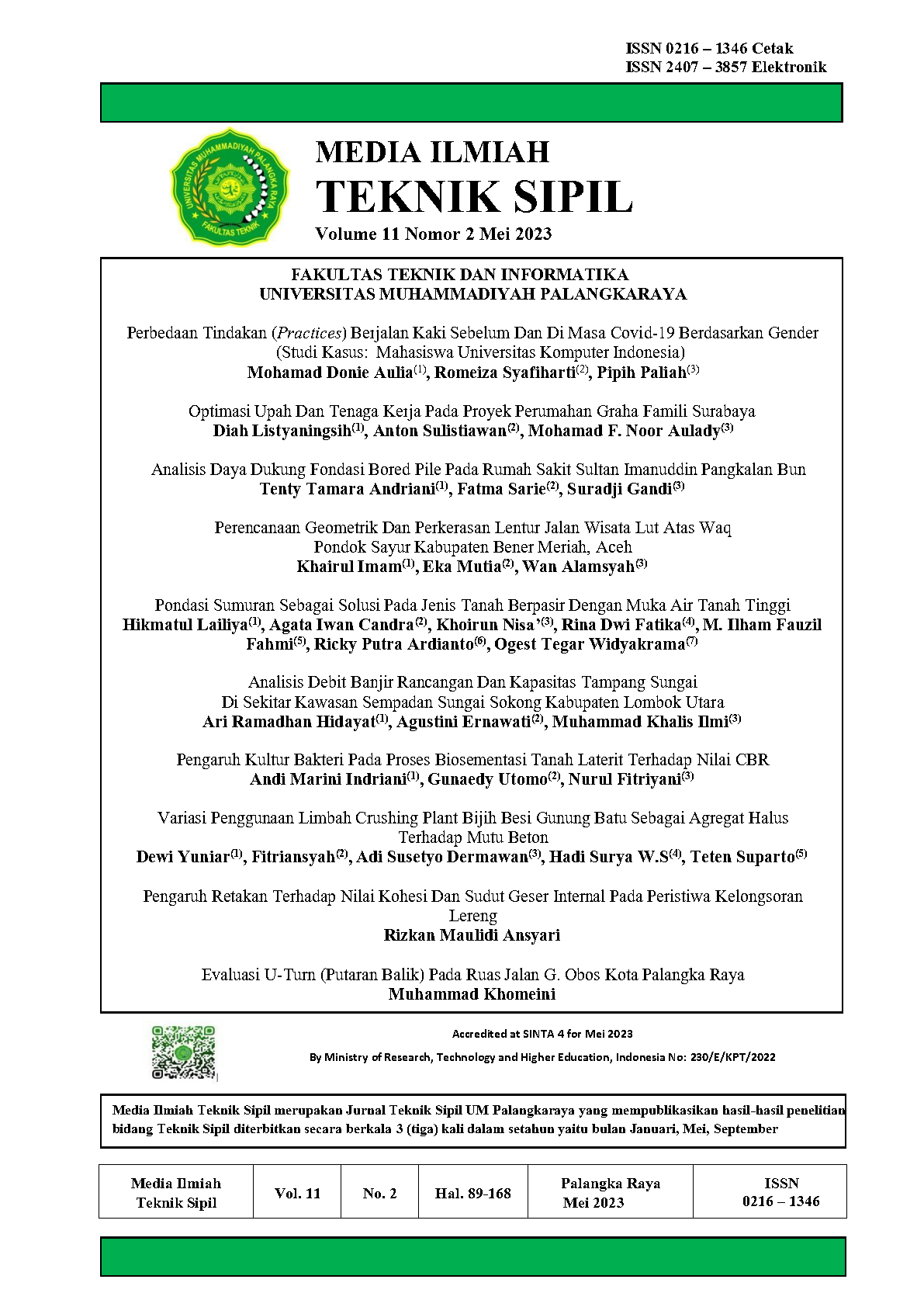Pengaruh Kultur Bakteri Pada Proses Biosementasi Tanah Laterit Terhadap Nilai CBR The Influence Of Bacterial Culture On The Soil Laterite Biosementation Process On CBR Value
Main Article Content
Abstract
Lateritic soils have a high rate of weathering and non-uniform shrinkage. So this land is not good for construction work. Biocementation is a method of soil improvement by using the ability of bacteria that have lived in the soil to do the MCIP (Microbial-induced Calcite Precipitation) process which is obtained from the bacterium Bacillus Subtilis. This biocementation stabilization can increase the strength of the soil by adding Bacillus Subtilis bacteria as an additive to stabilize the soil. The test was carried out to determine changes in the mechanical properties of CBR Laboratory soil, by mixing 3% bacteria into the soil to be stabilized. The results of testing the CBR value of the Soaked Laboratory with one day of culture increased 4.8-fold at the 28-day curing period and increasing the CBR value of the Soaked Laboratory of three-day culture increased up to 4.9 times the CBR value before stabilization, which was 19.5%. The results of the study with stabilization using bacteria variation of 3% one-day culture increased up to 95% and increased up to 96% in three-day culture. So that it can be used as a soil material for road foundations in class B.
Downloads
Article Details

This work is licensed under a Creative Commons Attribution-ShareAlike 4.0 International License.
All rights reserved. This publication may be reproduced, stored in a retrieval system, or transmitted in any form or by any means, electronic, mechanical, photocopying, recording.
References
Ain, M. I. M., & Soeparlan, A. A. (2020). Pengaruh Penggunaan Batu Laterit Sebagai Alternatif Pengganti Agregat Kasar Pada Kekuatan Beton. Journal Dynamic Saint, 4(2), 869–875.
Arianto, B. (2020). Studi Potensi Resiko Tanah Lunak dalam Pembangunan Ibu Kota Negara dengan Ajuan Penanganan Menggunakan Metode Prefabricated Vertical Drain Berbahan Alami. Jurnal Teknik: Media Pengembangan Ilmu Dan Aplikasi Teknik, 19(2), 171–180.
DeJong, J. T., Fritzges, M. B., & Nüsslein, K. (2006). Microbially Induced Cementation to Control Sand Response to Undrained Shear. Journal of Geotechnical and Geoenvironmental Engineering, 132(11), 1381–1392.
Hasriana, Samang, L., Harianto, T., & Djide, M. N. (2018). Bearing capacity improvement of soft soil subgrade layer with Bio Stabilized Bacillus Subtilis. MATEC Web of Conferences, 181, 0–5.
Hendriyani, I., Marini, A., & Intan Putri, N. (2018). Analisis SWOT Pemilihan Material Dinding Bata Merah dan Bata Ringan di Penajam Paser Utara. Borneo Engineering : Jurnal Teknik Sipil, 2(1), 22.
Indriani, A. M., Harianto, T., Djamaluddin, A. R., & Arsyad, A. (2021). Study on Bio-cementation of Ex-coal Mining Soil as a Road Construction Material (pp. 193–201).
Indriani, Andi Marini, Harianto, T., Djamaluddin, A. R., & Arsyad, A. (2021). Bioremediation Of Coal Contaminated Soil As The Road Foundations Layer. International Journal Of Geomate, 21(84), 76–84.
Indriani, Andi Marini, Utomo, G., & Rizqy, M. (2022). Konstruksi Dengan Metode Earned Value Analysis. Geo Economi, 13(September 2022), 128–137.
Lim, A., Muhammad, D. A., & Lestari, A. S. (2019). Studi Eksperimental Kemampuan Biosementasi Bakteri Lokal pada Tanah Pasir Lepas. Jurnal Teknik Sipil, 26(2), 129.
Marini, A., Harianto, T., Djamaluddin, D. A. R., & Arsyad, A. (n.d.). Karakteristik Tanah Terkontaminasi Batubara Terstabilisasi Bakteri Sebagai Lapis Pondasi Jalan.
Marini, A., Utomo, G., & Nur Fadhillah, M. (2021). Pengaruh Semen Pada Tanah Lempung Plastisitas Rendah Terhadap Nilai Cbr. Jurnal Ilmiah Teknik Sipil TRANSUKMA, 4(1), 23–32.
Mujah, D., Cheng, L., & Shahin, M. A. (2019). Microstructural and Geomechanical Study on Biocemented Sand for Optimization of MICP Process. Journal of Materials in Civil Engineering, 31(4), 1–10.
Nurdin, M., Purwana, Y. M., & Setiawan, B. (2017). Pengaruh Microbakteri Bacilus Suptilus Dan Psidomonas Sp Terhadap Penurunan Permeabilitas Dan Peningkatan Kuat Geser Tanah Pasir. Matriks Teknik Sipil, 5(3), 1122–1129.
Oyediran, I. A., & Ayeni, O. O. (2020). Comparative effect of microbial induced calcite precipitate, cement and rice husk ash on the geotechnical properties of soils. SN Applied Sciences, 2(7).
Tang, C. S., Yin, L. yang, Jiang, N. jun, Zhu, C., Zeng, H., Li, H., & Shi, B. (2020). Factors affecting the performance of microbial-induced carbonate precipitation (MICP) treated soil: a review. Environmental Earth Sciences, 79(5).
Yusran, M., Indriani, A. M., & Utomo, G. (2022). Perumahan Graha Indah Balikpapan Drainage System Planning In Graha Indah Housing Area Balikpapan. 2022(Senastika), 90–99.
